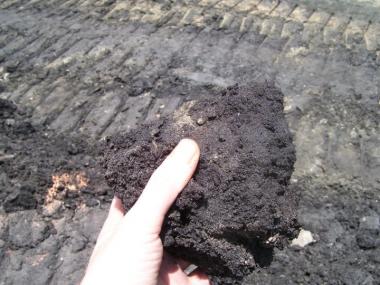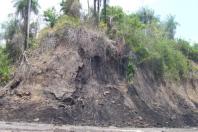Tar sands mining in T&T A recipe for mass destruction

Canadian activist Macdonald Stainsby says T&T could be turned into a toxic wasteland for hundreds of years if the Government goes ahead with its plan for tar sands mining. He said the effects of the noxious smoke emanating from fires set in the Beetham Landfill in January that engulfed Port-of-Spain and environs forcing the closure of several companies, schools, sending people with respiratory illnesses to the hospital and the devastating effect on the environment by Petrotrin’s oil spills in the south-west peninsula would be magnified many times over if T&T followed Canada’s tar sands mining model.
Stainsby is author of the report Tar Sands in T&T? A Look at the Dirtiest Oil from Canada to T&T. Canadian singer-songwriter Neil Young compared the effects of tar sands mining in Canada to Hiroshima in terms of its destruction on the landscape and people. Young is currently holding a series of benefit concerts to raise money to support Athabasca Chipewyan First Nations’ legal battle to halt the expansion of the Athabasca oil sands in northern Alberta and other similar projects, which they contended had caused cancer rates to rise in their communities and contaminated their lands and water. Speaking in a telephone interview with the Sunday Guardian from British Columbia, Stainsby said the negative impact on animal life, livelihood and health of residents from those two incidents in Trinidad paled in comparison to the ecological damage being wrought in Canada from tar sands mining.
Massive toxic impacts
The anti-tar sands activist and environmentalist said this could lead to water and soil contamination with highly toxic carcinogenic chemicals for hundreds of years, water shortages, blackouts, massive deforestation and possible relocation of communities. Stainsby said, “What is happening now is only a precursor to what would be the long term potential because a requirement of tar sands mining would be the collection of the toxic residue waste water with all the heavy metals. “Some of them are mercury, arsenic, lead, zinc, cadmium, uranium, ethylene glycol, radium, methanol, hydrochloric acid and formaldehyde, as well as polycyclic aromatic hydrocarbons collecting in giant toxic holding ponds.” He said at the end of 600 years, a good chunk of the water will have settled enough that it could be returned to the regular water tables, but in the meantime La Brea will need to have something like a giant pit to contain that contaminated water.
Stainsby said on average four barrels of fresh water were needed to produce one barrel of oil from tar sands.
He said if T&T’s output was estimated at 40,000 barrels of oil a day, they will have to use 120,000 to 160,000 barrels of fresh water a day in a region where people needed it in their taps.
Stainsby said tar sands waste water stored in tailings ponds in Canada leaked out; if there was a small earthquake, it could conceivably trigger a crack in the dams and burst with catastrophic effect. He said if that toxic waste water was released at one time in an area like La Brea, it would be inhabitable almost immediately as it was densely populated. Stainsby said if the tailings ponds were near the coast in the south-western peninsula, and there was even a slight rise in the sea levels for a short period of time, it could pull all of the contaminated water into the Gulf of Paria. He said it wouldn’t just immediately flow straight into the ocean but would settle in the outlying community areas.
People getting cancers
Stainsby said the waste water had caused health concerns in people who lived much further away from the developments of the Athabasca tar sands in Alberta, widely regarded as the largest source of bitumen deposits in the world. He said First Peoples who lived 200 kilometres downstream of the tar sands were sick and dying from the water contamination, suffering from breathing problems such as emphysema and asthma and developing cancers. Stainsby said it was estimated that it will take 600 years for the ponds in Canada to settle enough where the metals can break down naturally. He said the mining of tar or oil sands quarries in the south of Trinidad can be described as environmental rape as it will entail strip mining two to four tons of soil in giant conveyor belts to produce one barrel of oil for such a small country. Stainsby said the area mined in Canada was the equivalent of England and Wales put together, while T&T was only 12 to 13 square kilometres.
In October 2013 a Trinidad Generation Unlimited (TGU) power generation facility located on the Union Industrial Estate, Vessigny Village, La Brea, was opened. In July 2013 a desalination plant was opened in Point Fortin. Stainsby said tar sands mining needed large amounts of clean water; the desalination plant could provide the large water supply needed to refine bitumen from tar sands. He said such a large supply of water doesn’t exist on land because it is a very dry region and the rivers were too shallow for the purpose. In April 2012 at the Summit of the Americas in Colombia, Prime Minister Kamla Persad-Bissessar participated in Caricom-Canada talks with Canadian Prime Minister Stephen Harper. On her return from the summit, Persad-Bissessar said the Government was looking into a tar sands venture in which Canadian expertise would be applied.
In July 2011, the National Gas Company and the National Energy Corporation signed a memorandum of understanding with Reliance Group, of India, for a bitumen upgrading plant to produce synthetic crude oil. The proposed site for the plant was the La Brea Industrial Estate. In a February 2011 address at the opening of the National Energy Policy consultations in Sangre Grande, then energy minister Carolyn Seepersad-Bachan mentioned tar sands as a viable solution to increasing crude oil production in T&T. In the address, she acknowledged the environmental challenges to tar sands, but noted that there were international examples of safe mining. On August 8, 2000, then prime minister Basdeo Panday officially opened the refurbished Pointe-a-Pierre refinery. Stainsby said the refinery hasn’t been operating anywhere near capacity for a long period of time and the Government had spent billions on refurbishing it several year ago and now it has a caulker that can handle bitumen better.
In February 2009 then energy minister Conrad Enill announced that Cabinet had agreed to give Petrotrin a licence to explore tar sands in south Trinidad. Estimates suggested that almost two billion barrels of crude oil could be extracted from the existing bitumen deposits. Stainsby said the construction of the San Fernando to Point Fortin Highway will play an integral role and would be the first step in opening up the region to extracting oil from tar sand deposits. He said the highway will bypass most of San Fernando and reach almost all the way to the Pointe-a-Pierre refinery. The Royal Bank of Canada (RBC) returned to T&T in 2008. RBC is the largest financier of tar sands in Canada. Stainsby said all these developments may or may not have anything to do with the mining of tar sands but they were the same components in place for tar sands mining in Canada; and all of a sudden, they were showing up within a few miles of each other right by where the tar sands existed in Trinidad.
These areas include Vessigny, La Brea, Guapo and Parrylands. Stainsby said what was happening in the south-west was almost like a warning to change direction. But that decision should be made by the people in T&T, he thought, and he said he was just giving information based on what Canada went through. To find out more about the global movement against tar sands, you can visit Stainsby’s Web site: http://oilsandstruth.org and http://www.tarsandsworld.com/ You can also follow “Papa Bois Conservation” on Facebook.
What is tar sands?
Tar sands or oil sands are bitumen deposits mixed with clay and sand. Bitumen is a black viscous mixture of hydrocarbons obtained naturally or as a residue from petroleum distillation.
How is it mined?
Tar sands can be mined in two ways. The first is low impact surface mining. The second is called in-situ. In-situ is primarily a process called Steam Assisted Gravity Drainage. In this process, areas are completely cleared of forest coverage, then water is suctioned off from the surface area. After all water is removed, “overburden” or soil, roots etc, are removed and collected. The bitumen is extracted (digging can get as deep as 600 feet) and taken to a slurry. The slurry uses natural gas to heat fresh water and mix tar sands until the clay and dirt are separated from the bitumen.
How much water does it contaminate?
It is estimated that three to five barrels of fresh water are contaminated during the production of one barrel of synthetic oil.
Vessigny Village resident Anslym Carter, who protested against the smelter, said that the impacts of tar sands mining would be far worse than those of a smelter. Carter said areas in La Brea would become barren and nothing would grow there for years. Carter said he was shown what the land looked like in Canada after tar sands mining and described it as “very frightening.”
No consultations
He said some people had very short memories and there were no consultations with residents for the purpose of the industrial plants being set up in the vicinity of the Pitch Lake; almost as if authorities were trying to sneak in tar sands mining projects. He said La Brea residents must be concerned with what was taking place in their community and they must not sacrifice their health to “eat ah food” and for temporary work and money. Carter revealed that several residents hired by Petrotrin to help clean up the oil spills were getting sick with respiratory illnesses as they were not equipped with the proper safety equipment and breathing gear.
Petrotrin licenced to explore for tar sands
Stainsby revealed that Petrotrin has been granted a licence for tar sands exploration. Jamaludin Khan, Petrotrin’s vice president of exploration and production, did not respond to the e-mail sent to him up to publication time. Energy Minister Kevin Ramnarine also did not reply to the emails sent to him and could not be contacted. Ramnarine was recently in China as part of Prime Minister Kamla Persad-Bissessar’s T&T delegation to hold bilateral talks with the Chinese Premier and top officials of the Chinese Government. Among the proposals is the removal of asphalt from the Pitch Lake in greater capacities.


